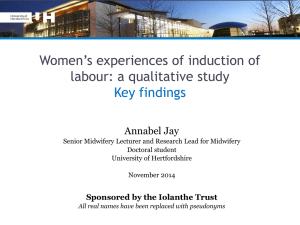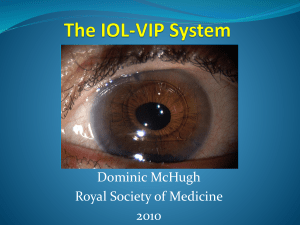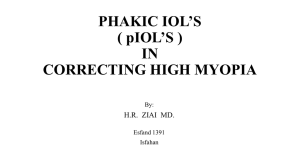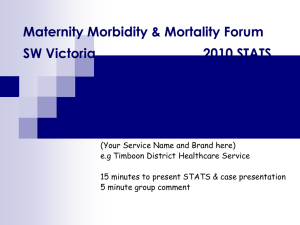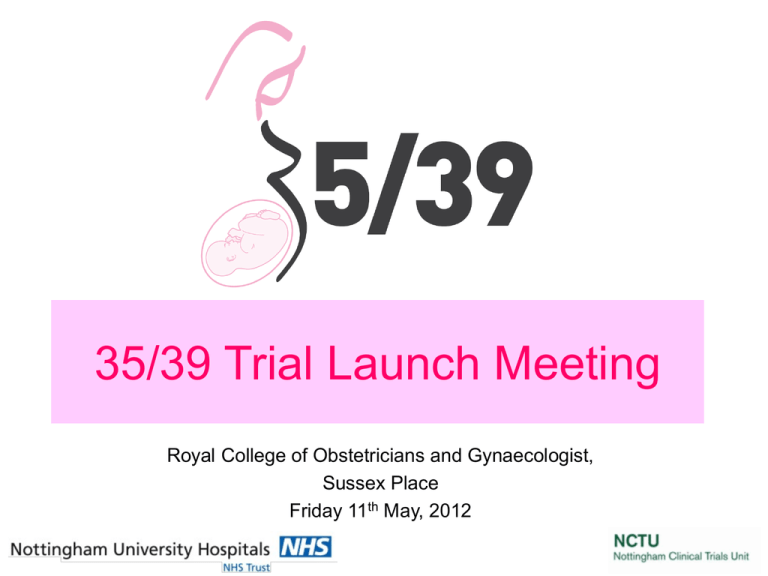
35/39 Trial Launch Meeting
Royal College of Obstetricians and Gynaecologist,
Sussex Place
Friday 11th May, 2012
Programme
1000-1015 hours
Welcome and introduction
Professor Jim Thornton (JGT), Chief Investigator
1015-1045 hours Background – literature/protocol
Dr Kate Walker (KW), Trial Manager
1045-1115 hours Coffee
1115 -1230 hours Participant pathway – recruitment/randomisation/
data collection/CEQ - KW
1230- 1330 hours Lunch
1330-1345 hours How to get CLRN support - JGT
1345-1400 hours Approaching the trial from a CLRN midwife’s perspective
Nicky Grace, CLRN Research Midwife
1400-1500 hours Problems / Discussion – we will present examples of
frequently encountered problems and propose solutions
but will also invite the audience to ask their own
questions and discuss solutions
KW/NG – chaired by JGT
1500 hours
Closing Remarks – JGT
Ideas for other trials
PICO
Population
Nulliparous women with a singleton live fetus who will be
over 35 years of age at their expected date of delivery
Intervention
Induction of labour between 390/7 and 396/7 weeks
gestation
Comparison
Women will be assigned to expectant
management
Outcome
Primary end point: Caesarean delivery
Secondary end points:
o Operative vaginal delivery
o Perinatal mortality
o Serious neonatal morbidity
o Maternal satisfaction
Relevant literature
Background
• 1996: 12% of live births were to women
over 35 years
• 2006: 20%.
• 2006: 5.6% of live births were to
nulliparous women over the age of 35
years.
Maternal effects
Gestational diabetes
Pregnancy induced
hypertension
Severe pre-eclampsia
OR 3.8 (Favilli et al)
OR 3.4 (Jacobbson et al)
OR 3.29 (Jacobbson et al)
AOR 1.4 (Jacobbson et al)
Placenta praevia
AOR 4.1 (Jacobbson et al)
Placental abruption
AOR 1.8 (Joseph et al)
Fetal effects
Preterm birth <32
weeks
Preterm birth < 37
weeks
SGA < 3rd centile
ARR 2.4
SGA < 10th centile
ARR 1.6
ARR 1.8
ARR 2.1
Perinatal death
ALL PERINATAL DEATHS
• 0.6% women aged 30-34 yrs (LOWEST
RISK GROUP)
• 0.8% women 35-40 years
• 1% women over 40 years
Perinatal death at term
• Main increase in risk of stillbirth for women over
35 years is 39 to 41 weeks.
• Women over 40 years old have a similar stillbirth
risk at 39 weeks as women who are between 25
and 29 years old at 41 weeks
• Once they pass 40 weeks gestation their risk of
stillbirth exceeds that of all women < 40 years
old at term1.
1. Reddy et al, AJOG, 2006
Risk of antepartum stillbirth by
maternal age
1. Reddy et al, AJOG, 2006
Quantifying the risk in women of
AMA
• Risk of stillbirth at 37-41 weeks for women
35-39 1 in 382 ongoing pregnancies (RR
1.32)
• Risk of stillbirth at 37-41 for women 40
years or older 1 in 267 ongoing
pregnancies (RR 1.88)
1. Reddy et al, AJOG, 2006
Obstetric intervention
1. GCS Smith et al, PLOS, 2008
Obstetric intervention
Nulliparous women
• > 35 years = 38%
• > 40 years = 50%
(Joseph et al, 2005)
Nulliparous women in labour at term (excl. breech)
• 35-39 years = 23%
• > 40 years = 27%
(GCS Smith, unpublished data, maternities 2004-2008)
Correct denominator
number of all perinatal deaths in a given week
PMR =
number of all births in a given week
• Need to consider the cumulative risk of stillbirth
at any gestational age.
• Although the PMR is lowest at 41 weeks, the
gestational age associated with the lowest
cumulative risk of perinatal death is 38 weeks1
1. GCS Smith, 2001
Rescue the ground floor
Average cost of a Level 3
NICU admission = £17,861
Cost of IOL = £289
Neonatal cost of IOL at 39/40
Lowest cumulative risk of
stillbirth 38/401
Largest increase in SB risk
starts at 39/402
The risk of developing
neonatal respiratory
symptoms for babies
born by vaginal delivery
falls from a probability of
0.07 at 37 weeks to 0.04
at 39 weeks and
thereafter plateaus3
1. Smith GC 2001
2. Reddy et al, 2006
3. Heinzmann et al,
2009
Maternal cost of IOL
• Longer
• More painful – Italian
cohort study – greater
epidural analgesic dose
required1, greater epidural
usage (23% induced
labour, spontaneous
delivery, 11% spontaneous
labour and delivery2)
• Complications
• ??? LSCS
1. Capogna et al, 2001
2. NHS Maternity Statistics
2005-06
Existing evidence for IOL at term
• Growing body of evidence that induction of
labour at term does not increase
emergency caesarean section rates and
does not increase intrapartum deaths.
Existing evidence for IOL at term
Trial / Meta-analysis
Author +
journal
Caesarean section rates or relative
risk
Term PROM: IOL vs.
expectant management
for term prelabour rupture
of membranes
Hannah et al,
NEJM, 1996
IOL with oxytocin 10.1%
Expectant Mx then oxytocin 9.7%
IOL with PG 9.6%
Expectant Mx with PG 10.9%
Post dates: Cochrane
Review of 18 trials
comparing IOL with
expectant Mx
Gülmezoglu
et al,
Cochrane
Review 2006
IOL 37-40 completed weeks RR 0.58
IOL at 41completed weeks RR 0.92
IOL at 42 completed weeks RR 0.97
HYPITAT: IOL vs.
expectant Mx for PIH and
mild PET after 36/40
Koopmans et
al, Lancet,
2009
IOL 14%
Expectant 19%
DIGITAT: IOL versus
expectant monitoring for
IUGR at term
Boers et al,
2010
IOL 14%
Expectant 13.7%
Existing evidence for IOL at term
• A recent trial of IOL at term for women
identified as high risk for emergency CS
(higher the risk score, earlier the
induction), found in the treatment group a
similar CS rate, a higher vaginal birth rate
and a reduced NICU admission and
adverse outcome rate1.
1. Nicholson et al, 2008
Current practice
• 3% offer IOL at term to women aged 35-39 yrs
• 37% - women aged 40 – 44 yrs
• 55% - women aged 45 yrs +
Acceptability to women
• Surveyed 663 women –
either pregnant or delivered in
the last 5 years
• 43% women would consider
IOL for maternal age alone
• 29% would consider
participating in an RCT in a
future pregnancy
Views for
•
•
•
•
•
•
•
•
[If] there is no risk to the baby I would welcome helping in a study […] to
potentially reduce stillbirths
I'm a great believer in taking the expert's advice […]. I would trust the doctors if
they recommended induction
Going late is horrendous for most pregnant women.
I understand the importance of such studies and although I haven't experienced
stillbirth I would do anything to avoid it. I have been induced in 3/4 of my
pregnancies and there were no complications and had normal deliveries.
Unfortunately, I have direct experience of stillbirth when I was aged 33. I
subsequently had another baby aged 35 [and] was induced at 40wks+3days,
having been very closely monitored throughout the pregnancy
Because at 39 weeks I felt ready to have my baby and consider 37 to 42 weeks
to be full term. I would also not like to be overdue again, particularly if I was
over 35 and there were increased risks.
Am aware that older mothers have more problems. Long time waiting for this
pregnancy. Would hate anything to go wrong.
I was induced at 40+11 at age 40 and feel very angry that they left the induction
so late […]
Views against
•
•
•
•
•
•
•
•
•
•
I'd want to help, but would be slightly worried that by NOT having the earlier
induction I would be putting my baby at risk.
Don't want someone else making choice for me
Age alone is not reason enough to prompt medical intervention.
Completely irrational to base a major cascade of intervention purely on one
relatively minor factor. [..] participating in such a study could be terrifying for a
mother assigned to the non-intervention group.
So many inductions end in Caesarean, so I'd be reluctant to have one.
I would rather be scanned every day and be induced at term if necessary if the
risks of still birth were great enough
Pregnancy lasts between 38 and 42 weeks, I don't understand this medical
obsession with giving birth at exactly 40 weeks.
Statistics are useful for doctors looking at big patterns but are not useful for me
personally
I do not agree with the ethics of the study. I do not believe that any woman
should be induced unless there is a specific medical risk for that woman. I do
not agree with induction at 39 weeks or 42 weeks just because "there's a risk of
stillbirth after that point".
I do believe that induction can cause health problem for the mother and
problems with breastfeeding.
PICO
Population
Nulliparous women with a singleton live fetus who will be
over 35 years of age at their expected date of delivery
Intervention
Induction of labour between 390/7 and 396/7 weeks
gestation
Comparison
Women will be assigned to expectant
management
Outcome
Primary end point: Caesarean delivery
Secondary end points:
o Operative vaginal delivery
o Perinatal mortality
o Serious neonatal morbidity
o Maternal satisfaction
Overview
AIMS
Primary: to establish what affect a policy of induction of labour at 39
weeks for nulliparous women of advanced maternal age has on the
rate of Caesarean section deliveries.
Secondary: to act as a pilot study for a trial to answer the question,
does induction of labour in this group of women improve perinatal
outcomes?
DURATION
24 months – from June 11th 2012
PARTICIPATING CENTRES
14 currently
CENTRE
PRINCIPAL
INVESTIGATOR
LEAD CLRN MIDWIFE/NURSE
Bradford Royal Infirmary
Professor Derek Tuffnell
Tracey Germaine
Derriford Hospital, Plymouth
Dr Ross Welch
TBC
Sunderland Royal Hospital
Mr Kim Hinshaw
Eileen Walton, Gill Campbell, Karen Armstrong
Derby Royal Hospital
Mr Daniel Hay
Jill Smith
RUH, Bath
Mr David Walker
Sara Burnard
Frimley Park Hospitals NHS Foundation
Trust
Alison Kirkpatrick
TBC
York Teaching Hospitals
Mr James Dwyer
Louise O'Higgins and Sara Collier-Hield
Princess Anne Hospital, Southampton
Mr Matthew Coleman
Jane Forbes
Shrewsbury and Telford Hospitals NHS
Trust
Dr Sheena Hodgett
Karen Henderson
Newcastle Upon Tyne Hospitals NHS
Foundation Trust
Dr Suzie Jackson
Claire Leader
Leighton Hospital, Crewe
Dr Karen McIntyre
Janet Brown and Caroline Dixon
Addenbrookes Hospital
Mr Christoph Lees
TBC
Leicester Royal Infirmary
Dr Marwan Habiba
TBC
a) Queen's Medical Centre Campus
Mr George Bugg
Yvette Gunn
b) Nottingham City Hospital Campus
Professor Jim Thornton
Nicky Grace
Nottingham University Hospitals NHS Trust
Intervention and Comparison
TREATMENT GROUP
Induction of labour between 390/7 and 396/7 weeks gestation
CONTROL GROUP
Expectant management i.e. awaiting spontaneous onset of labour unless a situation
develops necessitating either induction of labour or Caesarean Section.
•
•
•
Offer induction of labour anywhere between T+7 and T+14, the exact time to be
determined by consultant’s usual practice.
No additional monitoring in the expectant management group prior to T+14 will be
offered.
If the patient declines induction of labour at T+14 the patient will be offered a scan for
growth and liquor volume and offered alternate day or daily CTG monitoring
depending on the consultants usual practice.
Outcomes
Maternal
• Mode of delivery
• Onset of labour
• Indication for induction of
labour
• Method of induction of labour
• Indication for Caesarean
section
• Intrapartum complications
• Postpartum morbidity
Neonatal
• Live birth or stillbirth
• Birth weight
• Sex
• Death before discharge from
hospital
• Apgar scores
• Cord blood artery pH and BD
• Cord blood vein pH and BD
• NICU admission
• Birth trauma
Outcomes
Outcomes for pilot study
• The recruitment rate per
hospital.
• The age distribution of
participating women.
• Compliance with the treatment
arms of the trial.
• The overall gestational age
distribution of the two groups.
• Completeness of outcome data
Maternal satisfaction
• Childbirth Experience
Questionnaire1
• 22 questions
• Approx 5-10 minutes
1. Dencker et al, BMC
Pregnancy and Childbirth
2010
INCLUSION CRITERIA
EXCLUSION CRITERIA
1. Nulliparous
2. Maternal age over 35 years old at the EDD
2. Women with a contraindication to labour
or vaginal delivery
3. Singleton, live fetus
4. Cephalic presentation
5. Gestational age between
360/7
and
390/7
6. No medical contra-indication to induction
of labour
7. No medical contra-indication to pregnancy
being allowed to proceed to term plus 10
days
8. Willingness to participate in the trial
9. Written informed consent
1. Fetus with a known lethal congenital
abnormality
3. Women with a contraindication to
expectant management
4. Women with a previous myomectomy
5. Women who book late for antenatal care
and have no dating scan performed before
22 weeks
6. Women who have undergone IVF using
donor eggs in the current pregnancy
Any questions
Coffee until 11.15
35/39 Trial Launch Meeting
Royal College of Obstetricians and Gynaecologist,
Sussex Place
Friday 11th May, 2012
Programme
1000-1015 hours
Welcome and introduction
Professor Jim Thornton (JGT), Chief Investigator
1015-1045 hours Background – literature/protocol
Dr Kate Walker (KW), Trial Manager
1045-1115 hours Coffee
1115 -1230 hours Participant pathway – recruitment/randomisation/
data collection/CEQ - KW
1230- 1330 hours Lunch
1330-1345 hours How to get CLRN support - JGT
1345-1400 hours Approaching the trial from a CLRN midwife’s perspective
Nicky Grace, CLRN Research Midwife
1400-1500 hours Problems / Discussion – we will present examples of
frequently encountered problems and propose solutions
but will also invite the audience to ask their own
questions and discuss solutions
KW/NG – chaired by JGT
1500 hours
Closing Remarks – JGT
Ideas for other trials
Participant Pathway
Provide PIS at booking to
women aged ≥35 years
At booking appt –
identify eligible patient
Consent and randomise
patient
at 360/7 – 396/7
IOL between
390/7 and 396/7
Outcome data and CEQ
Expectant management
Outcome data and CEQ
Trial Website
www.35-39.org
http://www.nottingham.ac.uk/mczseafood/35-39/index.html.
Trial database
Participant Consent Form
1. I confirm that I have read and understand the information sheet dated
____________ (version _______ ) for the above study and have
had the opportunity to ask questions.
2. I understand that my participation is voluntary and that I am free to
withdraw at any time without my medical care or legal rights being
affected.
3. I understand that my medical records and my baby’s medical records
may be looked at by authorised individuals from the Sponsor for the
study, or the Independent Ethics Committee in order to check that
the study is being carried out correctly.
4. I understand that even if I withdraw from the above study, the data
collected from me will be used in analysing the results of the trial,
unless I specifically withdraw consent for this.
5. I consent to the storage including electronic, of personal information
for the purposes of this study. I understand that any information that
could identify me will be kept strictly confidential and that no
personal information will be included in the study report or other
publication.
6. I agree that my GP, or any other doctor treating me, will be notified of
my participation in this study.
7. I understand that I may be contacted in the future if further research
projects arising from this one are conducted. (OPTIONAL)
8. I agree to take part in the study.
Childbirth Experience
Questionnaire (CEQ)
Validated in 920 nulliparous women
22 questions
Format – four point response choices or visual analogue scale
Childbirth Experience
Questionnaire (CEQ)
Childbirth Experience
Questionnaire (CEQ)
35/39 Trial Launch Meeting
Royal College of Obstetricians and Gynaecologist,
Sussex Place
Friday 11th May, 2012
Programme
1000-1015 hours
Welcome and introduction
Professor Jim Thornton (JGT), Chief Investigator
1015-1045 hours Background – literature/protocol
Dr Kate Walker (KW), Trial Manager
1045-1115 hours Coffee
1115 -1230 hours Participant pathway – recruitment/randomisation/
data collection/CEQ - KW
1230- 1330 hours Lunch
1330-1345 hours How to get CLRN support - JGT
1345-1400 hours Approaching the trial from a CLRN midwife’s perspective
Nicky Grace, CLRN Research Midwife
1400-1500 hours Problems / Discussion – we will present examples of
frequently encountered problems and propose solutions
but will also invite the audience to ask their own
questions and discuss solutions
KW/NG – chaired by JGT
1500 hours
Closing Remarks – JGT
Ideas for other trials
Problems
•
•
•
•
•
•
•
•
•
•
•
•
Approval / regulatory problems
GCP training. How to get it.
Patients who insist on IOL outside trial
Patients who change their mind after randomisation
Patients who insist on IOL at T + 1-10
Can patients be recruited to more than one trial?
How should the induction group be induced?
What if she draws IOL and the cervix is like a carrot even after 24
hours of Propess?
Can people be induced with Foley catheter?
How should the control group be monitored?
What if a control develops pre-eclampsia, term PROM, turns breech,
or other problem after randomisation?
Women’s who’s IOL is delayed due to a busy LS
Problems
•
•
•
•
•
•
•
•
•
•
•
•
Approval / regulatory problems
GCP training. How to get it.
Patients who insist on IOL outside trial
Patients who change their mind after randomisation
Patients who insist on IOL at T + 1-10
Can patients be recruited to more than one trial?
How should the induction group be induced?
What if she draws IOL and the cervix is like a carrot even after 24
hours Propess?
Can people be induced with Foley catheter?
How should the control group be monitored?
What if a control develops pre-eclampsia, term PROM, turns breech,
or other problem after randomisation?
Women’s who’s IOL is delayed due to a busy LS
Problems
•
•
•
•
•
•
•
•
•
•
•
•
Approval / regulatory problems
GCP training. How to get it.
Patients who insist on IOL outside trial
Patients who change their mind after randomisation
Patients who insist on IOL at T + 1-10
Can patients be recruited to more than one trial?
How should the induction group be induced?
What if she draws IOL and the cervix is like a carrot even after 24
hours Propess?
Can people be induced with Foley catheter?
How should the control group be monitored?
What if a control develops pre-eclampsia, term PROM, turns breech,
or other problem after randomisation?
Women’s who’s IOL is delayed due to a busy LS
Problems
•
•
•
•
•
•
•
•
•
•
•
•
Approval / regulatory problems
GCP training. How to get it.
Patients who insist on IOL outside trial
Patients who change their mind after randomisation
Patients who insist on IOL at T + 1-10
Can patients be recruited to more than one trial?
How should the induction group be induced?
What if she draws IOL and the cervix is like a carrot even after 24
hours Propess?
Can people be induced with Foley catheter?
How should the control group be monitored?
What if a control develops pre-eclampsia, term PROM, turns breech,
or other problem after randomisation?
Women’s who’s IOL is delayed due to a busy LS
Problems
•
•
•
•
•
•
•
•
•
•
•
•
Approval / regulatory problems
GCP training. How to get it.
Patients who insist on IOL outside trial
Patients who change their mind after randomisation
Patients who insist on IOL at T + 1-10
Can patients be recruited to more than one trial?
How should the induction group be induced?
What if she draws IOL and the cervix is like a carrot even after 24
hours Propess?
Can people be induced with Foley catheter?
How should the control group be monitored?
What if a control develops pre-eclampsia, term PROM, turns breech,
or other problem after randomisation?
Women’s who’s IOL is delayed due to a busy LS
Problems
•
•
•
•
•
•
•
•
•
•
•
•
Approval / regulatory problems
GCP training. How to get it.
Patients who insist on IOL outside trial
Patients who change their mind after randomisation
Patients who insist on IOL at T + 1-10
Can patients be recruited to more than one trial?
How should the induction group be induced?
What if she draws IOL and the cervix is like a carrot even after 24
hours Propess?
Can people be induced with Foley catheter?
How should the control group be monitored?
What if a control develops pre-eclampsia, term PROM, turns breech,
or other problem after randomisation?
Women’s who’s IOL is delayed due to a busy LS
Problems
•
•
•
•
•
•
•
•
•
•
•
•
Approval / regulatory problems
GCP training. How to get it.
Patients who insist on IOL outside trial
Patients who change their mind after randomisation
Patients who insist on IOL at T + 1-10
Can patients be recruited to more than one trial?
How should the induction group be induced?
What if she draws IOL and the cervix is like a carrot even after 24
hours Propess?
Can people be induced with Foley catheter?
How should the control group be monitored?
What if a control develops pre-eclampsia, term PROM, turns breech,
or other problem after randomisation?
Women’s who’s IOL is delayed due to a busy LS
Problems
•
•
•
•
•
•
•
•
•
•
•
•
Approval / regulatory problems
GCP training. How to get it.
Patients who insist on IOL outside trial
Patients who change their mind after randomisation
Patients who insist on IOL at T + 1-10
Can patients be recruited to more than one trial?
How should the induction group be induced?
What if she draws IOL and the cervix is like a carrot even after 24
hours Propess?
Can people be induced with Foley catheter?
How should the control group be monitored?
What if a control develops pre-eclampsia, term PROM, turns breech,
or other problem after randomisation?
Women’s who’s IOL is delayed due to a busy LS
Problems
•
•
•
•
•
•
•
•
•
•
•
•
Approval / regulatory problems
GCP training. How to get it.
Patients who insist on IOL outside trial
Patients who change their mind after randomisation
Patients who insist on IOL at T + 1-10
Can patients be recruited to more than one trial?
How should the induction group be induced?
What if she draws IOL and the cervix is like a carrot even after 24
hours Propess?
Can people be induced with Foley catheter?
How should the control group be monitored?
What if a control develops pre-eclampsia, term PROM, turns breech,
or other problem after randomisation?
Women’s who’s IOL is delayed due to a busy LS
Problems
•
•
•
•
•
•
•
•
•
•
•
•
Approval / regulatory problems
GCP training. How to get it.
Patients who insist on IOL outside trial
Patients who change their mind after randomisation
Patients who insist on IOL at T + 1-10
Can patients be recruited to more than one trial?
How should the induction group be induced?
What if she draws IOL and the cervix is like a carrot even after 24
hours Propess?
Can people be induced with Foley catheter?
How should the control group be monitored?
What if a control develops pre-eclampsia, term PROM, turns breech,
or other problem after randomisation?
Women’s who’s IOL is delayed due to a busy LS
Problems
•
•
•
•
•
•
•
•
•
•
•
•
Approval / regulatory problems
GCP training. How to get it.
Patients who insist on IOL outside trial
Patients who change their mind after randomisation
Patients who insist on IOL at T + 1-10
Can patients be recruited to more than one trial?
How should the induction group be induced?
What if she draws IOL and the cervix is like a carrot even after 24
hours Propess?
Can people be induced with Foley catheter?
How should the control group be monitored?
What if a control develops pre-eclampsia, term PROM, turns breech,
or other problem after randomisation?
Women’s who’s IOL is delayed due to a busy LS
Problems
•
•
•
•
•
•
•
•
•
•
•
•
Approval / regulatory problems
GCP training. How to get it.
Patients who insist on IOL outside trial
Patients who change their mind after randomisation
Patients who insist on IOL at T + 1-10
Can patients be recruited to more than one trial?
How should the induction group be induced?
What if she draws IOL and the cervix is like a carrot even after 24
hours Propess?
Can people be induced with Foley catheter?
How should the control group be monitored?
What if a control develops pre-eclampsia, term PROM, turns breech,
or other problem after randomisation?
Women’s who’s IOL is delayed due to a busy LS
Delegate’s questions
Thank you for
listening and safe
journey home

